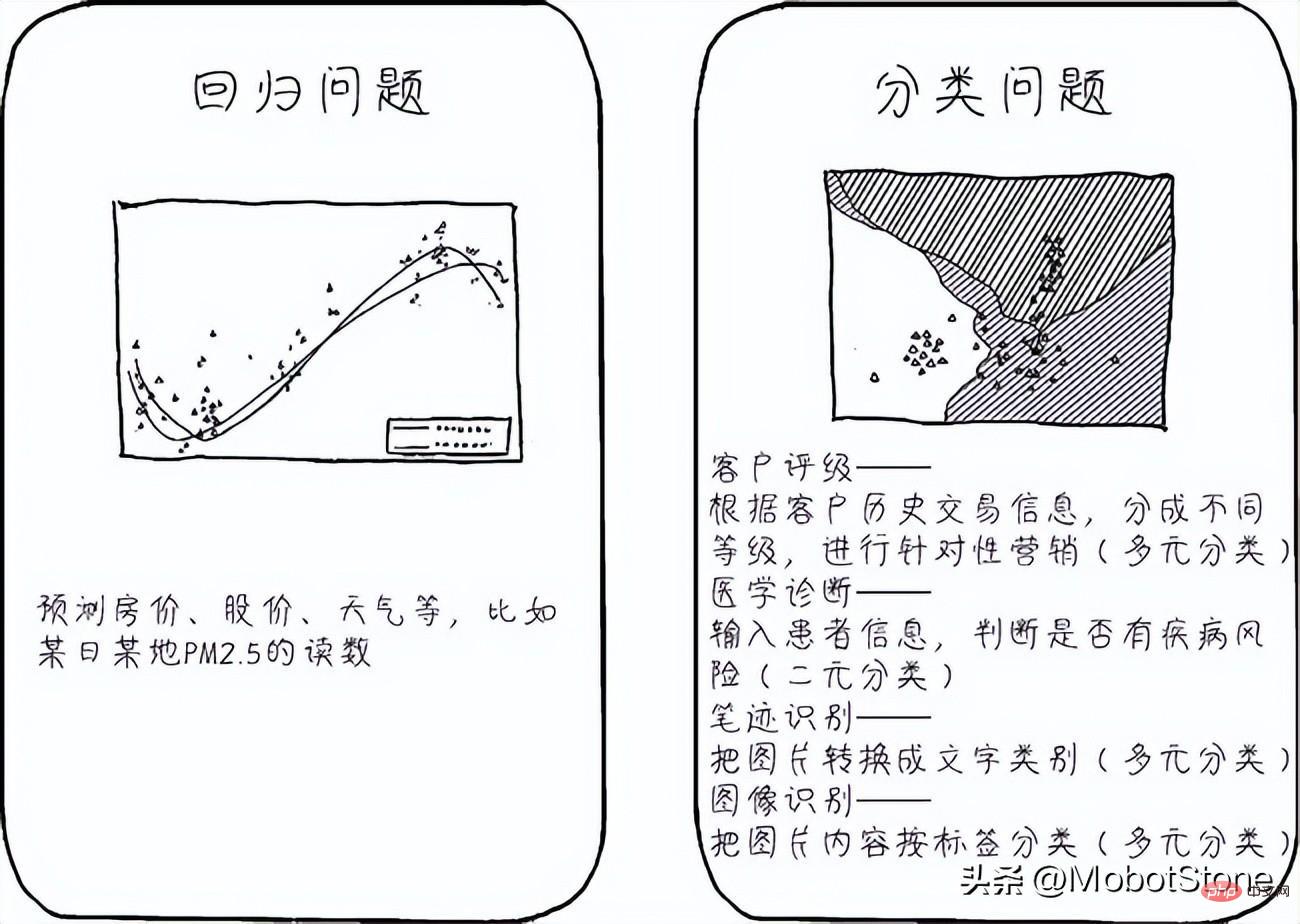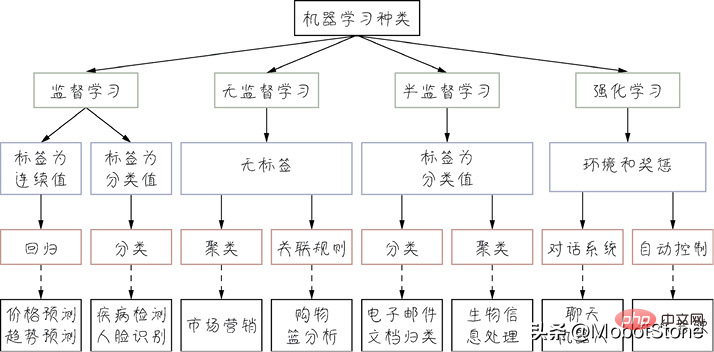What are the applications of machine learning?
Two major application scenarios of machine learning—regression and classification
Regression and classification are the two most common types of machine learning problems, as shown in the figure below.

Regression problems are usually used to predict a value whose label values are continuous. For example, predict any continuous trends and values such as house prices and future weather. The more common regression algorithms are linear regression algorithms and neural networks in deep learning.
The classification problem is to label things with a category label, and the result is a discrete value, which is an option in the category. For example, determining whether the animal on a picture is a cat or a dog. Classification includes binary classification and multivariate classification, and there is only one final correct result for each class. Classification is a classic application field of machine learning. Many machine learning algorithms can be used for classification, including the most basic logistic regression algorithm, the classic decision tree algorithm, and neural networks in deep learning. There are also multi-label classification problems derived from multi-category classification. Typical applications include the automatic labeling of names when uploading photos on social networking sites, and recommendation systems - recommending multiple products to the same user on a website or app, or Recommend a certain product to multiple users.
Other application scenarios of machine learning
Of course, in addition to regression problems and classification problems, there are many application scenarios of machine learning. For example, the most common clustering problem in unsupervised learning is to divide data into different clusters according to the nature of their features without labels (in fact, it is data classification); another type of unsupervised learning is association Rules by which the influence relationships between features can be found.
Another example is time series, which refers to a data set whose internal structure changes regularly over time, such as trend data, data that changes with seasons, etc. The time series problem is actually a regression problem closely related to time and period. Specific application scenarios include predicting fluctuations in financial markets, inferring solar activity, tides, weather and even the birth of stars and the formation of galaxies, predicting the spread of epidemic diseases, etc.
There is also structured output. Usually machine learning outputs an answer or option, but sometimes it is necessary to output a structure through learning. What does that mean? For example, in speech recognition, the machine outputs a sentence. The sentence has a standard structure, not just the numbers 0 to 9 (recognizing 0 to 9 is a classification problem). This is a step further than ordinary classification problems. Specific application scenarios include speech recognition - outputting sentences with correct grammatical structure, and machine translation - outputting articles that comply with regulations.
The goal of some machine learning problems is not to solve problems, but to make the world more colorful. Therefore, AI can also perform the work done by artists, such as the following. Google's Dreamwork can combine the styles of two pictures for artistic style migration. Generative adversarial network GAN can create pictures that look real. Mining the latent space of digital feature vectors to create music, news, stories, etc.
We can call this machine learning application generative learning.
There are also times when the goal of machine learning is to make decisions, which are called decision-making problems. Decision-making problems are still essentially classification problems, because each decision actually uses the most appropriate behavior to classify a certain state of the environment. For example, the direction (left, center, right) in autonomous driving and the landing point in Go are still one of the 19×19 categories. Specific application scenarios include autonomous driving, intelligent agents playing games, robots playing chess, etc. In many decision-making problems, machines must learn which decisions are effective and can bring rewards, which decisions are ineffective and will bring negative returns, and which ones are beneficial to long-term goals. Therefore, reinforcement learning is a common technique in this case.
In general, the trick of machine learning is to understand your own problem and choose the best machine learning method (algorithm) for your problem, that is, to find which technology is most likely to be suitable for this problem. Condition. If you can connect scenarios or tasks with appropriate technologies, you can have an idea when you encounter a problem and quickly locate a solution. The following figure connects some common machine learning application scenarios and machine learning models

The above is the detailed content of What are the applications of machine learning?. For more information, please follow other related articles on the PHP Chinese website!

Hot AI Tools

Undresser.AI Undress
AI-powered app for creating realistic nude photos

AI Clothes Remover
Online AI tool for removing clothes from photos.

Undress AI Tool
Undress images for free

Clothoff.io
AI clothes remover

AI Hentai Generator
Generate AI Hentai for free.

Hot Article

Hot Tools

Notepad++7.3.1
Easy-to-use and free code editor

SublimeText3 Chinese version
Chinese version, very easy to use

Zend Studio 13.0.1
Powerful PHP integrated development environment

Dreamweaver CS6
Visual web development tools

SublimeText3 Mac version
God-level code editing software (SublimeText3)

Hot Topics
 1378
1378
 52
52
 This article will take you to understand SHAP: model explanation for machine learning
Jun 01, 2024 am 10:58 AM
This article will take you to understand SHAP: model explanation for machine learning
Jun 01, 2024 am 10:58 AM
In the fields of machine learning and data science, model interpretability has always been a focus of researchers and practitioners. With the widespread application of complex models such as deep learning and ensemble methods, understanding the model's decision-making process has become particularly important. Explainable AI|XAI helps build trust and confidence in machine learning models by increasing the transparency of the model. Improving model transparency can be achieved through methods such as the widespread use of multiple complex models, as well as the decision-making processes used to explain the models. These methods include feature importance analysis, model prediction interval estimation, local interpretability algorithms, etc. Feature importance analysis can explain the decision-making process of a model by evaluating the degree of influence of the model on the input features. Model prediction interval estimate
 Implementing Machine Learning Algorithms in C++: Common Challenges and Solutions
Jun 03, 2024 pm 01:25 PM
Implementing Machine Learning Algorithms in C++: Common Challenges and Solutions
Jun 03, 2024 pm 01:25 PM
Common challenges faced by machine learning algorithms in C++ include memory management, multi-threading, performance optimization, and maintainability. Solutions include using smart pointers, modern threading libraries, SIMD instructions and third-party libraries, as well as following coding style guidelines and using automation tools. Practical cases show how to use the Eigen library to implement linear regression algorithms, effectively manage memory and use high-performance matrix operations.
 Explainable AI: Explaining complex AI/ML models
Jun 03, 2024 pm 10:08 PM
Explainable AI: Explaining complex AI/ML models
Jun 03, 2024 pm 10:08 PM
Translator | Reviewed by Li Rui | Chonglou Artificial intelligence (AI) and machine learning (ML) models are becoming increasingly complex today, and the output produced by these models is a black box – unable to be explained to stakeholders. Explainable AI (XAI) aims to solve this problem by enabling stakeholders to understand how these models work, ensuring they understand how these models actually make decisions, and ensuring transparency in AI systems, Trust and accountability to address this issue. This article explores various explainable artificial intelligence (XAI) techniques to illustrate their underlying principles. Several reasons why explainable AI is crucial Trust and transparency: For AI systems to be widely accepted and trusted, users need to understand how decisions are made
 Five schools of machine learning you don't know about
Jun 05, 2024 pm 08:51 PM
Five schools of machine learning you don't know about
Jun 05, 2024 pm 08:51 PM
Machine learning is an important branch of artificial intelligence that gives computers the ability to learn from data and improve their capabilities without being explicitly programmed. Machine learning has a wide range of applications in various fields, from image recognition and natural language processing to recommendation systems and fraud detection, and it is changing the way we live. There are many different methods and theories in the field of machine learning, among which the five most influential methods are called the "Five Schools of Machine Learning". The five major schools are the symbolic school, the connectionist school, the evolutionary school, the Bayesian school and the analogy school. 1. Symbolism, also known as symbolism, emphasizes the use of symbols for logical reasoning and expression of knowledge. This school of thought believes that learning is a process of reverse deduction, through existing
 Is Flash Attention stable? Meta and Harvard found that their model weight deviations fluctuated by orders of magnitude
May 30, 2024 pm 01:24 PM
Is Flash Attention stable? Meta and Harvard found that their model weight deviations fluctuated by orders of magnitude
May 30, 2024 pm 01:24 PM
MetaFAIR teamed up with Harvard to provide a new research framework for optimizing the data bias generated when large-scale machine learning is performed. It is known that the training of large language models often takes months and uses hundreds or even thousands of GPUs. Taking the LLaMA270B model as an example, its training requires a total of 1,720,320 GPU hours. Training large models presents unique systemic challenges due to the scale and complexity of these workloads. Recently, many institutions have reported instability in the training process when training SOTA generative AI models. They usually appear in the form of loss spikes. For example, Google's PaLM model experienced up to 20 loss spikes during the training process. Numerical bias is the root cause of this training inaccuracy,
 Improved detection algorithm: for target detection in high-resolution optical remote sensing images
Jun 06, 2024 pm 12:33 PM
Improved detection algorithm: for target detection in high-resolution optical remote sensing images
Jun 06, 2024 pm 12:33 PM
01 Outlook Summary Currently, it is difficult to achieve an appropriate balance between detection efficiency and detection results. We have developed an enhanced YOLOv5 algorithm for target detection in high-resolution optical remote sensing images, using multi-layer feature pyramids, multi-detection head strategies and hybrid attention modules to improve the effect of the target detection network in optical remote sensing images. According to the SIMD data set, the mAP of the new algorithm is 2.2% better than YOLOv5 and 8.48% better than YOLOX, achieving a better balance between detection results and speed. 02 Background & Motivation With the rapid development of remote sensing technology, high-resolution optical remote sensing images have been used to describe many objects on the earth’s surface, including aircraft, cars, buildings, etc. Object detection in the interpretation of remote sensing images
 Machine Learning in C++: A Guide to Implementing Common Machine Learning Algorithms in C++
Jun 03, 2024 pm 07:33 PM
Machine Learning in C++: A Guide to Implementing Common Machine Learning Algorithms in C++
Jun 03, 2024 pm 07:33 PM
In C++, the implementation of machine learning algorithms includes: Linear regression: used to predict continuous variables. The steps include loading data, calculating weights and biases, updating parameters and prediction. Logistic regression: used to predict discrete variables. The process is similar to linear regression, but uses the sigmoid function for prediction. Support Vector Machine: A powerful classification and regression algorithm that involves computing support vectors and predicting labels.
 Outlook on future trends of Golang technology in machine learning
May 08, 2024 am 10:15 AM
Outlook on future trends of Golang technology in machine learning
May 08, 2024 am 10:15 AM
The application potential of Go language in the field of machine learning is huge. Its advantages are: Concurrency: It supports parallel programming and is suitable for computationally intensive operations in machine learning tasks. Efficiency: The garbage collector and language features ensure that the code is efficient, even when processing large data sets. Ease of use: The syntax is concise, making it easy to learn and write machine learning applications.




